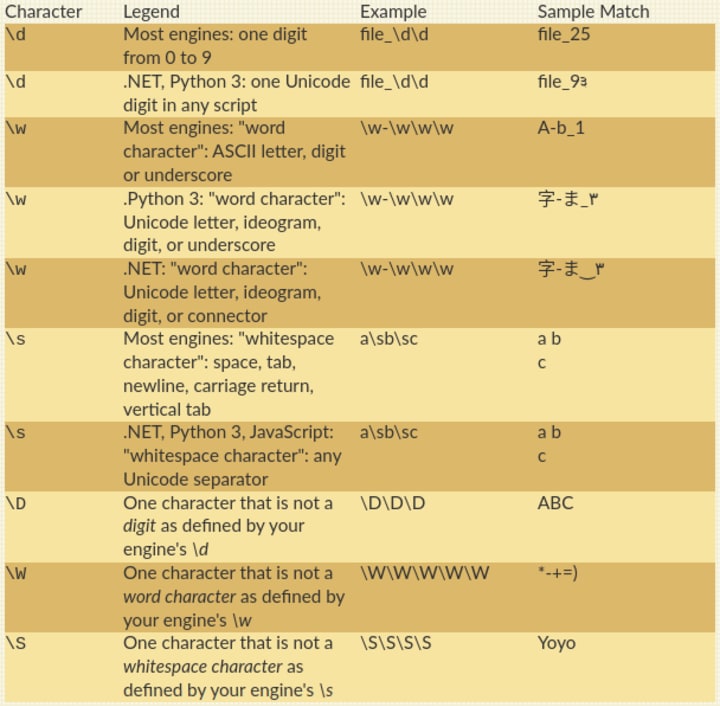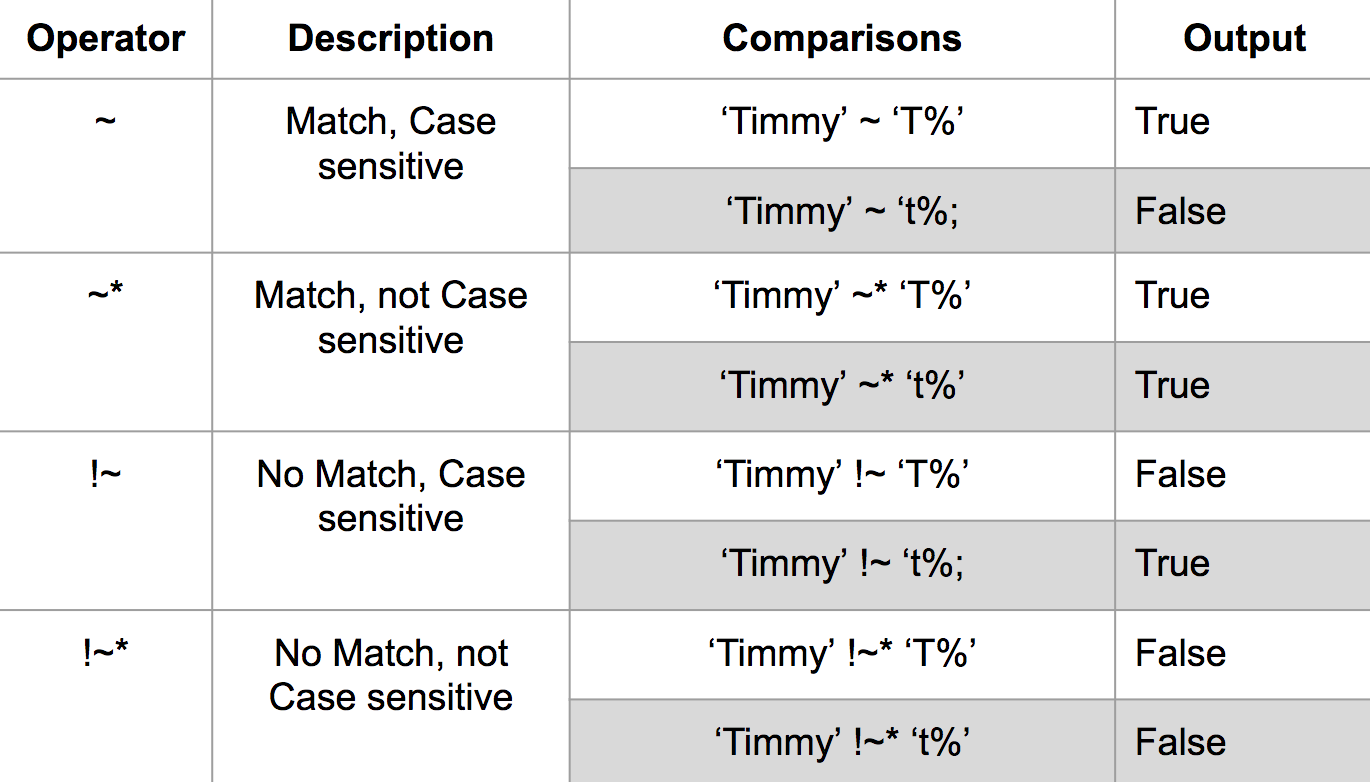Outiter regexreplace(outiter, firstiter, lastiter, const& regex, const& formatstr, flags) outstr regexreplace(const& input, const& regex, const& formatstr, flags) Replace substrings matching the regex according to the formatting string Regex flags affecting regexreplace formatnocopy Don't output the parts of the input string before and after the match. Regular Expressions Cheat Sheet. Anchors ^ Start of string, or start of line in multi-line pattern A. Start of string $ End of string, or end of line in multi-line. Cheat Sheet of Regular Expressions. Visit the post for more. Article by Xavier Ding. Regular Expression Infographic B Words Web Development Design Web Programming.
. matches almost any characterh.o matches hoo, h2o, h/o, etc.
Use to search for these special characters:[ ^ $ . | ? * + ( ) { }
ring? matches ring?
(quiet) matches (quiet)
c:windows matches c:windows
Regular Expression Cheat Sheet Python
id|identity matches id or identityregex engine is 'eager', stops comparing
as soon as 1st alternative matches

 , (NOT word, digit, or whitespace)
, (NOT word, digit, or whitespace) [DS] means not digit OR whitespace, both match
[^ds] disallow digit AND whitespace
colou?r match color or colour
* 0 or more[BW]ill[ieamy's]* match Bill, Willy, William's etc.
Regex Cheat Sheet Powershell
+ 1 or more[a-zA-Z]+ match 1 or more letters
{n} require n occurrencesd{3}-d{2}-d{4} match a SSN
{n,} require n or more[a-zA-Z]{2,} 2 or more letters
{n,m} require n - m[a-z]w{1,7} match a UW NetID
 (19|20)dd #year free spacing & EOL comment
(19|20)dd #year free spacing & EOL comment (see modifiers)
bring word starts with 'ring', ex ringtone
ringb word ends with 'ring', ex spring
b9b match single digit 9, not 19, 91, 99, etc..
b[a-zA-Z]{6}b match 6-letter words
B NOT word edgeBringB match springs and wringer
^ start of string $ end of string^d*$ entire string must be digits

^[a-zA-Z]{4,20}$ string must have 4-20 letters
^[A-Z] string must begin with capital letter
[.!?')]$ string must end with terminal puncutation
$_(GET|POST|REQUEST|COOKIE|SESSION|SERVER)[.+]
Can lead to catastrophic backtracking.
'id' matches, but 'b' fails after atomic group,
parser doesn't backtrack into group to retry 'identity'
C Sharp Regex Cheat Sheet
(?=ingb) match warbling, string, fishing, ... (?!w+ingb)w+b words NOT ending in 'ing'(?<=bpre).*?b match pretend, present, prefix, ...(?<!pre)w*?b words NOT starting with 'pre' (lookbehind needs 3 chars, w{3}, to compare w/'pre')
(?<!ing)b match words NOT ending in 'ing'A few examples:
- (?s)<p(?(?=s) .*?)>(.*?)</p> span multiple lines
- (?s)<p(?(?=s) .*?)>(.*?)</p> locate opening '<p'
- (?s)<p(?(?=s) .*?)>(.*?)</p> create an if-then-else
- (?s)<p(?(?=s) .*?)>(.*?)</p> lookahead for a whitespace character
- (?s)<p(?(?=s) .*?)>(.*?)</p> if found, attempt lazy match of any characters until ...
- (?s)<p(?(?=s) .*?)>(.*?)</p> closing angle brace
- (?s)<p(?(?=s) .*?)>(.*?)</p> capture lazy match of all characters until ...
- (?s)<p(?(?=s) .*?)>(.*?)</p> closing '</p>'
The lookahead prevents matches on PRE, PARAM, and PROGRESS tags by only allowing more characters in the opening tag if P is followed by whitespace. Otherwise, '>' must follow '<p'.
LOOKAROUND notes
- (?= ) if you can find ahead
- (?! ) if you can NOT find ahead
- (?<= ) if you can find behind
- (?<! ) if you can NOT find behind
The 2nd capture group collects the characters between the space and the newline.
This allows for any number of names/initials prior to lastname, provided lastname is at the end of the line.

Find: (.*)(?= .*n) (.*)n
Repl: 2, 1n — insert 2nd capture (lastname) in front of first capture (all preceding names/initials)
Find: (.*?), (.*?)n — group 1 gets everything up to ', ' — group 2 gets everything after ', '
Repl: 2 1n
(?=(sometext)) the inner () captures the lookahead
This would NOT work: ((?=sometext)) Because lookaround groups are zero-width, the outer () capture nothing.
re?d vs r(?=e)dre?d — match an 'r', an optional 'e', then 'd' — matches red or rdr(?=e)d — match 'r' (IF FOLLOWED BY 'e') then see if 'd' comes after 'r' - The lookahead seeks 'e' only for the sake of matching 'r'.
- Because the lookahead condition is ZERO-width, the expression is logically impossible.
- It requires the 2nd character to be both 'e' and 'd'.
- For looking ahead, 'e' must follow 'r'.
- For matching, 'd' must follow 'r'.
(?<=h1) or (?<=w{4}) look behind for 'h1' or for 4 'word' characters. (?<=w+) look behind for 1 or more word characters. The first few examples below rely on this ability.
Lookaround groups define the context for a match. Here, we're seeking .* ie., 0 or more characters.
A positive lookbehind group (?<= . . . ) preceeds. A positive lookahead group (?= . . . ) follows.
These set the boundaries of the match this way:
- (?<=<(w+)>).*(?=</1>) look behind current location
- (?<=<(w+)>).*(?=</1>) for < > surrounding ...
- (?<=<(w+)>).*(?=</1>) one or more 'word' characters. The ( ) create a capture group to preserve the name of the presumed tag: DIV, H1, P, A, etc.
- (?<=<(w+)>).*(?=</1>) match anything until
- (?<=<(w+)>).*(?=</1>) looking ahead from the current character
- (?<=<(w+)>).*(?=</1>) these characters surround
- (?<=<(w+)>).*(?=</1>) the contents of the first capture group
In other words, advance along string until an opening HTML tag preceeds. Match chars until its closing HTML tag follows.
The tags themselves are not matched, only the text between them.
To span multiple lines, use the (?s) modifier. (?s)(?<=<cite>).*(?=</cite>) Match <cite> tag contents, regardless of line breaks.
As in example above, the first group (w+) captures the presumed tag name, then an optional space and other characters ?.*? allow for attributes before the closing >.
- class='.*?bredb.*?' this new part looks for class=' and red and ' somewhere in the opening tag
- b ensures 'red' is a single word
- .*? allow for other characters on either side of 'red' so pattern matches
class='red'andclass='blue red green'etc.
Here, the first group captures only the tag name. The tag's potential attributes are outside the group.
- (?i)<([a-z][a-z0-9]*)[^>]*>.*?</1> set ignore case ON
- (?i)<([a-z][a-z0-9]*)[^>]*>.*?</1> find an opening tag by matching 1 letter after <
- (?i)<([a-z][a-z0-9]*)[^>]*>.*?</1> then match 0 or more letters or digits
- (?i)<([a-z][a-z0-9]*)[^>]*>.*?</1> make this tag a capture group
- (?i)<([a-z][a-z0-9]*)[^>]*>.*?</1> match 0 or more characters that aren't > — this allows attributes in opening tag
- (?i)<([a-z][a-z0-9]*)[^>]*>.*?</1> match the presumed end of the opening tag
(NB: This markup <a> would end the match early. Doesn't matter here. Subsequent < pulls match to closing tag. But if you attempted to match only the opening tag, it might be truncated in rare cases.)
- (?i)<([a-z][a-z0-9]*)[^>]*>.*?</1> lazy match of all of tag's contents
- (?i)<([a-z][a-z0-9]*)[^>]*>.*?</1> match the closing tag — 1 refers to first capture group
The IF condition can be set by a backreference (as here) or by a lookaround group.
- (()?d{3} optional group ( )? matches '(' prior to 3-digit area code d{3} — group creates back reference #1
- (?(1)) ?|[-/ .]) (1) refers to group 1, so if '(' exists, match ')' followed by optional space, else match one of these: '- / . '
- d{3}[- .]d{4} rest of phone number
For a quick overview: http://www.codeproject.com/KB/dotnet/regextutorial.aspx.
For a good tutorial: http://www.regular-expressions.info.
When it comes to extracting information or pattern from a string there we use regular expressing. In a regular expression, we use the ASCII code to perform the matching sting operation. Many form validation operations are made by using regular expression when a user enters some information at the same time form validate that data using a regular expression. Apart from validation, there are many other applications of regular Expression such as parsing, replacing strings, passing through translating data to different formats and extracting information from the web.
Many high-level programming languages also support Regular expression, and syntax of regular expressing is similar for each programming language.
What is Regex?
regex stands for the regular expression, and it is a technique to search string patterns from a string. It is used by many text editors such as Sublime, Notepad++, Brackets, Microsoft word, etc for search and replaces operations.
Regular Expression Cheat Sheet
Anchor:
C# Regex Cheat Sheet
| Expression | Description | Example: | Output Match |
| ^ | To check the starting point of a string. | ^Tech | any string starting with “Tech” Output: TechGeekbuzz |
| $ | To check the end of a string | $buzz | TechGeekbuzz |
Characters:
| Expression | Description | Example: | Output Match |
| d | A digit from 0 to 9 | “TechGeekbuzz dddd” | TechGeekbuzz2020 |
| w | Any ASCII letter, digit and underscore | “TechwGeekbuww” | Tech_Geekbuzz |
| s | whitespace | “TechsGeekbuzz” | Tech Geekbuzz |
| D | A character but not a digit | “TechDeekbuzz” | TechGeekbuzz |
| W | A character which is not a word. | “WTechGeekbuzz” | +TechGeekbuzz |
| . | Any Character exclude line break | T.B | TGB; TAB; TBB; .. |
| Escape next special character | TGB | TGB |
Quantifiers:
| Expression | Description | Example: | Output Match |
| * | Zero or More times; | TGB* | match a string which has TG followed by zero or more G Output: TG; TGB TGBBB; |
| + | One or more | TGB+ | match a string which has TG followed by one or more G Output: TGB; TGBB; |
| {d } | Exactly | TGB{5} | Match a string TG followed by exactly 5 B’s; Output: TGBBBBB |
| {d,d} | In between | TGB{3,5} | Match a string TG followed by 3 up to 5 B’s; Output: TGBBB; TGBBBB; TGBBBBB; |
| ? | Once or none | TGBs? | Output: TGBs; TGB; |
Logic:
| Expression | Description | Example: | Output Match |
| | | Or operator | 1|2 | Either be 1 or 2 |
| () | Group | T(echGeekBuzz|GB) | TechGeekBuzz; TGB; |
| 1 | Group the content by 1 | G(w)1gle | Google; Gaagle; Gbbgle; …. |
| 2 | Group the Content by 2 | “(dd) (ww) = 2 1” | 12 aa = aa 12; 11 bb = bb 11; ….; |
Brackets:
| Expression | Description | Example: | Output Match |
| [ ] | Any character from the bracket | “P[ae]n” | Pan; Pen; |
| – | Set a range | [a-z] | a; b; c; …; |
| [^] | Any character except those ones which are in brackets. | [^a-z] | A; B; C; …; 1; 2; … |
| [dD] | Any character whether it is a digit or a non-digit |
